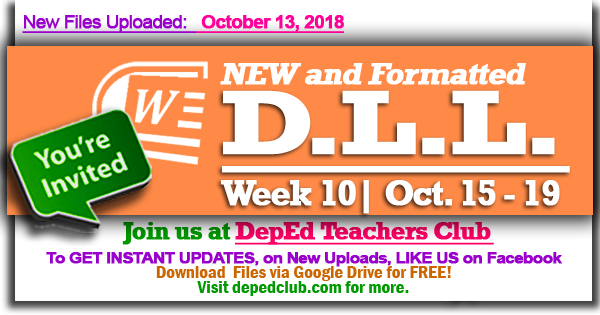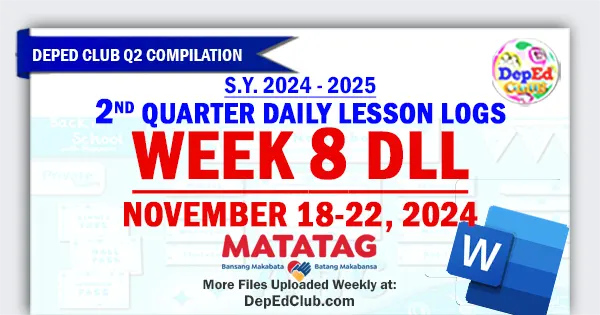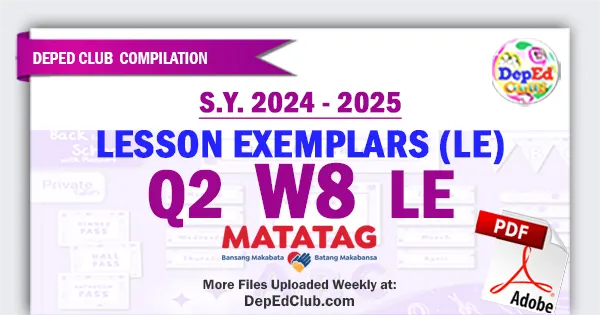Week 10 – 2nd Quarter Daily Lesson Log (October 15 – 19, 2018) | Weekly DLL are now available.
In the past academic years, we shared Daily Lesson Logs and other files submitted by our Contributors that are proofread and formatted by our File Editors. Let’s welcome this new and progressive school year of collaboration and support!
We are always on the process of uploading new and updated K-12 Daily Lesson Logs weekly.
For K-6, we are almost complete in uploading Daily Lesson Logs. Yet, we will keep on uploading new versions of DLL’s every week. Also, some DLL’s may be incomplete in some higher grade levels but rest assured, we will be uploading the additional DLL’s soon. Some DLL’s are still on the process of editing and formatting. Please take time to visit our website from time to time for new and unannounced K-12 Daily Lesson Logs.
We are always thankful to our Contributors, Editors and Tech Volunteers. They are the foundation of DepEd Teachers Club. We are always grateful to them and we ask for your continued support.
 All of these files can be downloaded for FREE via Google Drive.
All of these files can be downloaded for FREE via Google Drive.
Please keep on Sharing and Liking our contributions until all of our fellow teachers all around the country would benefit from these works too. May more blessings come upon us all. Thank you.
Different Teaching Styles in K to 12 Education
In order to effectively impart knowledge and become successful with students’ general development, teachers must portray good teaching styles, become more creative, flexible and knowledgeable. Teacher need to recognize individual differences among students and be able to adjust his/her teaching styles that best suit to the learners. As educators, we play varied and vital roles in the classroom and we are entrusted with so many responsibilities that range from the very simple to most complex and very challenging jobs.
We teachers are always motivated to discover new teaching styles, assessment instruments, instructional models and pedagogical techniques to be able to personalize and improve student learning. Understanding our students’ unique learning styles, preferences and instructional needs can assist us in developing a more favorable view of our students’ abilities and thereby stimulate the development and implementation of differentiated instructional practices and the provision of intentional and personalized intervention. An understanding of our students’ learning styles can increase our confidence and ability to incorporate varied instructional practices in a way that provides for differing levels of ability and unique student learning preferences while maintaining an appropriate level of academic rigor. Research has shown that incorporating learning styles based instructional strategies assists teachers in creating a comfortable learning environment, demonstrating true concern for their students, and promoting a love of learning (Honigsfeld & Schiering, 2004).
The following are the common teaching styles and learning styles that are pertinent and helpful in understanding our profession.
- Teacher-centered instruction. Teacher-centered instruction is also known as didactic instruction. It is a model in which teachers transmit information to students who assimilate that information and learn thereby. This type of instructional approach caters to and revolves around the teacher and the information the students are required to learn and for which they will be responsible. This style can include such strategies as a teacher presenting a lecture, students copying the teacher’s notes, and the teacher performing an experiment or demonstration for the students to observe. Didactic instruction may also take the form of teacher presentation of information followed by questioning and drill and practice such as completion of worksheets.
- Instructional model approaches. These approaches are a teacher’s means of applying an understanding of various learning styles in the development of philosophically sound instructional practices and teaching styles. These teaching styles deliberately address personal differences in students’ learning styles includes describing, interacting, controlling, selecting, instructing, and evaluating.
- Constructivism. In an attempt to move away from an approach centered on a teacher who continuously dispenses information or one singularly focused on a particular strategy for presenting instruction, there has recently been significant development of an interest in the constructivist approach to education. The foundational principal of constructivism is that learners construct knowledge through their experiences as well as reflections on and responses to those experiences. Thus, constructivism is a learner-centered approach founded upon the belief that learners derive knowledge through exploration and discovery and that they are continuously constructing and reconstructing meaning with each new experience they encounter.
- Experiential instruction. The goal of experiential instruction is to engage students mentally and emotionally in real-life experiences that will enable them to relate personally to the information presented. Reflection allows and encourages students to develop theoretical understanding from concrete experiences by providing a framework to guide them through the learning process and drives the transformation from passive learning to active doing. Teachers who effectively implement the experiential approach do not focus on the hands-on nature of constructivist experientialism to the exclusion of serious mental involvement.
- Brain-based teaching. The educational implications of neuro- and cognitive science have received increasing attention in recent years, leading to recognition of the fact that understanding the physiology and organization of the brain has practical applications for education. However, it would be inappropriate to assume that educators could utilize this brain research to derive a simple instructional approach that would promptly solve all educational and learning issues. With a cautious approach, however, it is enlightening to consider the structure and functions of the brain and to develop educational practices that make appropriate use of this knowledge. It is important to note educators still do not completely understand the complexity of the brain and its functional processes, but there is great potential to utilize this currently untapped knowledge to increase the effectiveness of education. Brain-based teaching advocates that both memory systems complement the other in the natural process of formulating meaning and should, therefore, both be used in educational practice in order to help students achieve meaningful learning that is characterized by numerous, high-quality connections that allow for easy access and retrieval whenever necessary.
- Differentiated instruction. Differentiated instruction can take on many images, but ultimately refers to the process of incorporating a variety of approaches and strategies for providing instruction, practice, and assessment. Founded upon teachers’ perceptions of student differences, the design of differentiation enables all students to utilize their individual styles, preferences, and interests in order to achieve academic success. The incorporation of choice, flexibility, and creativity, mingled with ongoing assessment strategies allow for variations in content, instructional methods, and demonstration of student learning. Thus, differentiated instruction provides a means of utilizing many different teaching styles and ideas from multiple instructional models in an effort to provide opportunities for students with any learning style to be successful.
Research show that several teaching styles could be employed by the teachers to encourage students to become self motivated independent learners. As identified, teachers must give frequent positive feedback that supports students’ beliefs that they can do well; ensure opportunities for students’ success by assigning tasks that are either too easy nor too difficult; help students find personal meaning and value in the material; and help students feel that they are valued members of a learning community. It is necessary for teachers to work from students’ strengths and interests by finding out why students are in your class and what are their expectations.
To help our fellow teachers, K-12 Daily Lesson Log (DLL) files are now available for FREE. You can download the files easily. No Adfly, safer and faster.
Just follow the links. May God bless us all!
Week 10 – 2nd Quarter Daily Lesson Log
October 15 – 19, 2018 | Weekly DLL
-
Updated! KINDERGARTEN Daily Lesson Log
-
Updated! GRADE 1 Daily Lesson Log
-
Updated! GRADE 2 Daily Lesson Log
-
Updated! GRADE 3 Daily Lesson Log
-
Updated! GRADE 4 Daily Lesson Log
-
Updated! GRADE 5 Daily Lesson Log
-
Updated! GRADE 6 Daily Lesson Log
-
GRADE 7 Daily Lesson Log
-
GRADE 8 Daily Lesson Log
-
GRADE 9 Daily Lesson Log
-
GRADE 10 Daily Lesson Log
-
SHS Daily Lesson Log



